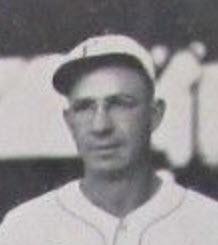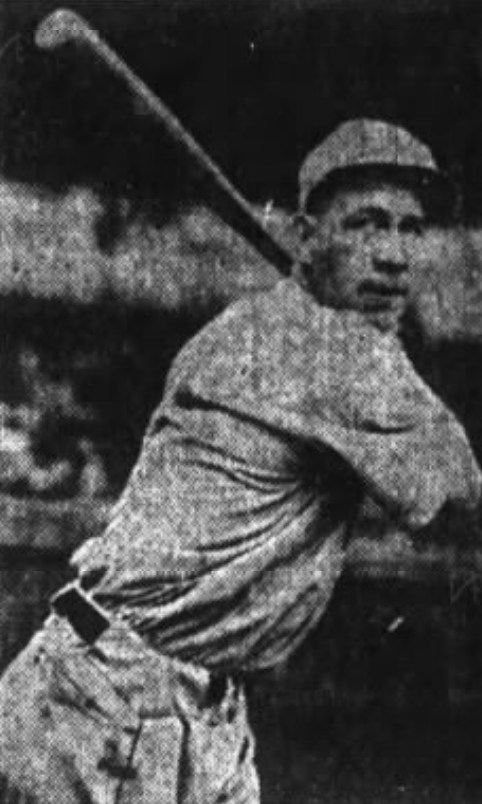Bob Crues.
69 HR
This article was written by BOB RIVES.
If Babe Ruth owns the number 60 and Barry Bonds has a lock on 73, the number 254 just as surely belongs to Bob Crues. Unfortunately, not many know it.
In 1948, Crues went on a rampage through the dusty and windswept ballparks of the Southwest, driving in 254 runs in just 140 games, dwarfing the major league record of 191 RBI set by
Hack Wilson with the Cubs in 1930. Playing for the Amarillo Gold Sox of the class C West Texas-New Mexico League, Crues drove in almost two runs per game that summer. Two! The closest anyone ever came to his total was former teammate Joe Bauman who drove in 224 one season. Tony
Lazzerl’s, who set the old record with 222, had to play in 197 games in 1925 to reach that mark at Salt Lake City in the Pacific Coast League. As the 21st century dawned, it seemed possible that Crues' RBI record will be one of the rare ones never to be broken.
But even when he was setting it, Bob's RBI record was being overshadowed by his home runs. Besides driving in runs at a record pace, scoring 185 runs and hitting .404 that summer, he also was hotly pursuing Joe Houser’s all-time home run record of 69 set with the Minneapolis Millers of the American Association in 1933. It was Crues' assault on that record that attracted fan and media interest and prompted fans to call him "Round Trip."
In fact, there is evidence that Crues was the first ever to hit 70 homers in a season. But one of them didn't count because an umpire may have ruled incorrectly at a game in Abilene, Texas.
On June 30, Amarillo played the Blue Sox in Abilene. Crues smashed a towering hit toward the scoreboard that bounced back on the field. Umpire
Frank Secory,
who three years earlier was playing in a World Series with the Cubs, ruled that the ball hit the fence and held Crues at third. After the game, the Abilene outfielders, scoreboard operator, and official scorer said the ball hit the scoreboard, not the fence, and should have been a home run.
Bill Chick, official scorer and league statistician, worried prophetically about the call. In a letter published by the Amarillo News-Globe, he said:
"Won't it be awful if he fails to get [number 70] when I'll always believe he should have had that one here in our park . . . and Frank Secory ruled that it hit the fence, when several Blue Sox players who should have been able to see the ball said it hit the scoreboard? I, too, thought it hit the scoreboard and should have been an automatic homer. I've been afraid ever since that that homer might play a bit part in breaking or not breaking that record."
It's little wonder that Chick and the Blue Sox players would do their best to help Bob. A Lubbock newspaper remarked, "It is safe to say that there isn't another player in the league with as many friends and admirers around the circuit as Crues owns. Wherever they go, because each game they cluster, young and old, around the big amiable home run king during all his idle moments near the dugout.
"Robert's prodigious feats of the 1948 season are, by the way, attracting national attention. Sporting News, the great baseball weekly, asked a few days ago for a picture of and a story about him that will appear in next Monday's issue. Latest report on his home run standing is to be wired additionally to the St. Louis publication Thursday morning. (Crues doesn't know about this yet.)"
Even with the setback in Abilene, the balding Bob tied Hauser's record of 69 with two games left in the season. His try for the 70th drew a record crowd of 4,851 for a season-ending Labor Day doubleheader with Lubbock. Ironically, Secory, the umpire who might have cost him a home run in Abilene, was working behind the plate.
Bob Crues
Robert Fulton Crues
Bats. R. Throws. R
Height. 6’ 2.
Weight. 185
Born. Dec. 31, 1918
Frisco, TX. USA
Died. Dec. 26, 1986
Amarillo. TX. USA.
Biographical Information
Bob Crues began his baseball career as a pitcher and went 20-5 in the West Texas-New Mexico League in his first full season, 1940. His contract was purchased by the
Boston Red Sox
but he went just 5-5 over the next two years, never making it to AA. Crues worked in an ammunition production plant (and married a co-worker) then was drafted into the Army during
world War 11.He lost three years of baseball time due to his military service.
When the war ended, Crues was 28 and a non-prospect. Lots of leagues were getting started or re-started, so jobs were plentiful and talent unevenly distributed. Crues returned to the WT-NM league where he had begun and hit .341 with 29 homers and 120 RBI. It was a high-octane league and Crues wasn't dominant; he finished 5th in homers (19
behind fellow minor league legend Joe Bauman ), 9th in RBI and might just have cracked the top 10 in average.
In 1947, Crues hit .380 with 52 homers and 178 RBI. He still wasn't the dominant force in a class C league. He was 6th in average, 5 homers behind leader Bill Serena and 12 RBI behind leader Serena; two others were within 5 RBI.
After being sold to
the Little Rock Travelers,
Crues was returned in time for the 1948 campaign. That season Crues had a record-setting year. Playing in a hitter-friendly park, he homered 69 times, tying Joe Hauser’s
minor league record. He also drove in 254, shattering Tony Lazzerl’s Pro record by 32 while playing in a shorter season. Crues also led the league with 185 runs. The Amarillo Gold Sox slugger hit .404, but didn't finish in the top 3 in the league nor was he among the top 3 in OBP despite drawing 90 walks to go with the .404. He led in slugging (.848) by 107 points, was third in hits (228) and 80 walks shy of the leader despite his high total (walks were plentiful in the pitching-weak circuit).
That off-season Crues got an offer from the Jackson Senators but miscommunication led to his release. He also was offered a shot at appearing in
the National Baseball
Congress
tourney but instead went to the
Roswell Rockets a
new team in the
Longhorn League,
another offense-oriented low minor league in the southwest. His .365 was 6th in the league and his 28 homers second (just 3 ahead of Carlos Pascual, who was known more as a pitcher) and his 129 RBI fourth. Crues, after one record-shattering year, was again merely a very good player in a very weak league.
In 1950 Crues won his second home run title in the minors, clubbing 32 for the
San Angelo Colts,
best of anyone in the Longhorn. He hit just .251 though in an average-loving league and finished just 12th in RBI. In 1951, Crues connected for just 16 homers while splitting the season between his two primary homes of the past, the WT-NM and the Longhorn.
Crues didn't even play in 1952 and a comeback in 1953 showed that he was already washed-up. Unlike Bauman, his former teammate and the man who broke his minor league home run record in 1954, Crues had really had just one great season. Like Bauman, it took place in one of the most friendly offensive contexts in baseball history. Still, no one has come closer than 30 of Crues' record RBI title, an impressive feat not to be denied.
After retirement, Crues became an excellent competitive bowler. In 1965, he had the first of several strokes and his health declined.
Sources include the
SABR Bioproject.

 Nearly two-thirds of Clabaugh’s 62 home runs were hit at Trojan Park in Tyler, so people naturally wondered about the ballpark’s dimensions. Indeed, he was helped by a close fence in right field; the distance from home plate to the right-field foul pole was only 250 feet.
Nearly two-thirds of Clabaugh’s 62 home runs were hit at Trojan Park in Tyler, so people naturally wondered about the ballpark’s dimensions. Indeed, he was helped by a close fence in right field; the distance from home plate to the right-field foul pole was only 250 feet.